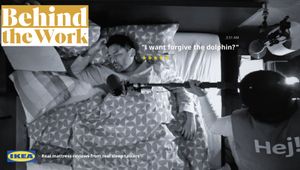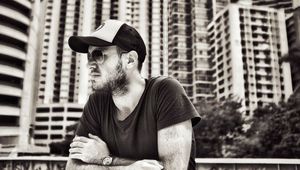
Wendy Walker on the Complex and Nuanced Nature of B2B Creativity

A complex category blending both short- and long-term brand-building strategies that not only connect with customers but drive brand growth, the Creative B2B Lions considers business product, proposition, service, solution or experience.
President of this year’s Creative B2B jury is Wendy Walker, VP marketing ASEAN at Salesforce, who brings over 25 years of interdisciplinary marketing experience across various industries. She is highly experienced in building, growing and transforming brands, and deeply passionate about driving both creative effectiveness and strong commercial results.
Ahead of the festival, Wendy speaks to LBB’s Sunna Coleman, about why work in the Creative B2B category needs to do more than just grab attention, how the category is evolving, and why it all starts with brand truth.
LBB> When it comes to judging, what do you personally look for, and how do you apply this to work that spans creativity, social impact, and measurable outcomes?
Wendy> At the heart of great B2B work is creative courage, anchored in clarity. The kind of work that knows exactly what it wants to say and expresses it with originality, emotion, and intent. In B2B, where complexity is a given, it is the ideas that distil, not dilute, that rise to the top.
This year, we are looking for work that challenges conventions, pushes boundaries, and redefines what is possible in B2B. We are looking for ideas rooted in powerful human insight, executed with authenticity, emotion, and strategic clarity. Creativity that simplifies the complex. Strategic thinking that drives real commercial and reputational impact. And above all, work that dares to move the industry forward.
For me, it starts with brand truth. Is the idea credible coming from this brand? Does it reflect a deep understanding of the audience, not just their role, but their mindset, motivations, and context? The strongest entries do not speak to a segment; they connect with a person. That human connection is what makes B2B work memorable and meaningful.
When judging work with a social or purposeful dimension, I look for alignment. Is the problem being solved relevant to the brand's sphere of influence? Is the solution real, measurable, and creatively delivered? Purpose without substance is easy to spot and even easier to forget.
And of course, effectiveness matters. But in B2B, effectiveness is not just about leads or conversions. It is about long-term trust, reputation, and transformation. The best work in this space shows bold creativity driving tangible business results. It builds the brand while delivering on performance.
It is still early, but some of what I am seeing already shows real impact and real craft. I am encouraged by the ambition. And as jurors, our role is to reward the work that does not just meet the moment but redefines what B2B creativity can be from here.
LBB> Are there any previous winners or pieces of work that inspire you within this category?
Wendy> Several previous winners have helped shape the standard of what exceptional B2B creativity can look like. Two in particular stand out to me.
Workday’s ‘Rock Star’ campaign brought celebrity power and cultural fluency into the B2B space with surprising confidence. For a long time, B2B creative was seen as safe, restrained, or overly rational. This campaign broke that pattern. It used humour and recognisable talent to tell a simple story about the modern workplace in a way that was fresh, entertaining, and absolutely relevant to its audience.
More importantly, it showed that B2B brands have every right to play in the mainstream and that emotional resonance and entertainment value do not compromise business credibility. It inspired a new wave of work that understands attention as a business advantage.
Then there is Sherwin-Williams’ ‘Speaking in Color’, the first-ever Grand Prix winner in the Creative B2B category. It used AI to let designers speak colour into existence. The concept was elegant, intuitive, and technologically advanced, turning a tool into a creative experience. It demonstrated how innovation can meet imagination, and how brands can evolve from service providers to creative partners. It was not just technically impressive, it was emotionally intelligent. And it positioned Sherwin-Williams in an entirely new light for an ecosystem of architects, designers, and commercial clients.
Both campaigns highlight different strengths. One brought bold storytelling and mass cultural appeal. The other showed the power of purposeful innovation and simplicity. But what they shared was clarity of intent, connection to audience, and a belief that B2B creativity can and should be world-class.
LBB> What are the current big debates within the category or more generally across the industry that you expect to see coming through in the jury room?
Wendy> Effectiveness will be a key point of discussion, especially how we define and measure it in B2B. It is no longer enough to show short-term results. The strongest work will demonstrate how creativity drives long-term brand equity, shifts reputation, and delivers sustained commercial impact. We will be looking closely at how campaigns move beyond awareness to build meaningful relevance with decision-makers and how that translates into real outcomes.
Another important conversation will be around the evolution of the category itself, particularly the increasing presence of B2B2C work. It reflects a real-world shift in how brands are operating, especially in sectors where influence on both business buyers and end consumers matters. These are credible, often highly creative campaigns, but they can challenge traditional B2B definitions.
The opportunity here is not to reject that complexity, but to bring more clarity to it. As a jury, our role is to assess whether the primary creative and commercial intent of the work still serves a business-to-business outcome and to judge it accordingly. I see this not as a dilution of the category, but as a sign of its expansion. It is proof that B2B creativity is becoming more fluid, more sophisticated, and more connected to broader ecosystems.
These kinds of debates are not distractions, they are necessary. They help us define the future shape of the category and ensure that the standards we set this year are both rigorous and reflective of how B2B brands are showing up in the world.
LBB> How can clients enable their creative agencies to unleash better campaigns and projects?
Wendy> It starts with trust, and it is built through clarity. When clients give agencies a clear brief grounded in brand truth, audience understanding, and a shared definition of success, they create the conditions for breakthrough work.
But beyond the brief, it is about permission. Permission to challenge assumptions. To simplify complexity. To make emotional connections in categories that are traditionally rational. When clients champion creative bravery internally, agencies are empowered to think bigger and go further. And that is when the magic happens.
LBB> What are some of the considerations of creative B2B which make it different to B2C advertising, and how does that impact the work?
Wendy> B2B decisions are often more complex, more expensive, and more accountable. The buying cycle is longer, the audience is smaller, and the stakes are higher. But at the core of it all, you are still speaking to people.
The difference lies in the nuance. In B2B, creativity has to do more than grab attention, it has to build trust. It has to turn technical propositions into emotionally resonant stories. And it has to do so with a level of strategic depth that reflects the sophistication of the decision-makers.
That complexity makes the creative challenge more interesting, and in many ways, more rewarding.
LBB> Outside of the jury room, what are you really looking forward to learning or doing at this year’s Cannes Lions?
Wendy> I am always energised by the cross-pollination that happens at Cannes, seeing how creativity is evolving across sectors, formats, and cultures. I am particularly looking forward to sessions that explore the intersection of AI, storytelling, and trust, and how these forces are reshaping brand building in B2B and beyond.
And of course, it is the human connections. The unexpected conversations on the Croisette or between panels, the shared reflections over coffee or rosé, the chance to learn from people you admire but do not often cross paths with.
LBB> Do you have any advice for people attending for the first time?
Wendy> Do not try to do it all. Curate your experience with intention. Choose a few themes that matter to you and follow them across talks, work, and conversations.
And carve out time to just observe. Some of the best inspiration does not happen on stage, it happens in the work itself, on the walls, or in conversations with people who see the world differently than you do.
Finally, be open. Be curious. And be generous, with your time, your perspective, and your energy. Cannes is a celebration of creativity, but it is also a reminder of the community behind it.















